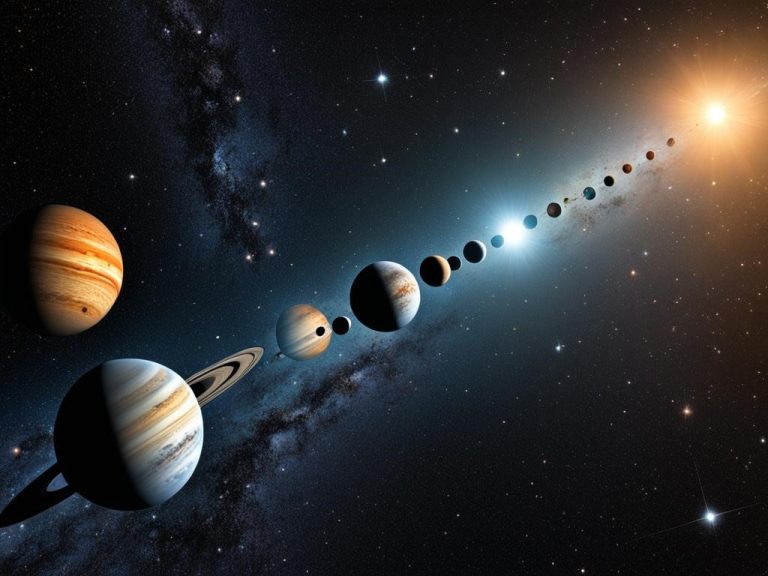Explore the Wonders of the Caelum Constellation
Modified: September 1, 2024 Author: International Star Registry
Did you know that the Caelum constellation is the eighth smallest in the night sky, covering only 125 square degrees? This small size doesn’t stop it from being a favorite among astronomers and enthusiasts. Let’s look into what makes Caelum special, including its past, key stars, and its importance in space.
Key Takeaways:
- The Caelum constellation is the eighth smallest constellation, spanning only 125 square degrees
- It can be observed at latitudes ranging from +40° to -90°
- Caelum was named by French astronomer Nicolas Louis de Lacaille in the 18th century
- Although it lacks associated myths, the constellation is home to three notable galaxies
- Caelum features significant stars such as Alpha Caeli, Gamma Caeli, and Beta Caeli

The Caelum constellation is also known as “the chisel,” named by the French astronomer Nicolas Louis de Lacaille in the 18th century. It’s visible from latitudes +40° to -90° in the southern sky. This constellation may be small and lack myths, but it still holds great interest for astronomers.
Caelum is next to constellations like Columba, Dorado, and Lepus. It is special because of its unique stars and galaxies. It doesn’t have Messier objects or stars with planets, but it is the home of three significant galaxies: NGC 1679, NGC 1571, and IC 2106.
Three stars in Caelum shine brighter than the rest: Alpha Caeli, Gamma Caeli, and Beta Caeli. Alpha Caeli is the brightest, at a magnitude of 4.44, and is 65.7 light-years away. Delta Caeli is also impressive, a blue-white star located 711 light-years from Earth.
Now that we’ve covered Caelum’s wonders, let’s look at why it’s important in astronomy. And how you can enjoy gazing at it too. Follow the links below to learn and maybe even name a star in this special constellation.
For more information about the Caelum constellation, check out these resources:
The Mythology and History of Caelum
Caelum stands out because it has no myths tied to it. But, its story is still quite interesting. It was named by a French astronomer, Nicolas Louis de Lacaille. He chose the name to honor the Sculptor’s Chisel.
In 1756, on his map of the Southern stars, Lacaille added Caelum. This showed his focus on the science of stars rather than mythical tales. The constellation is about tools and instruments in different fields, showing the value of human skills and creativity.
Caelum is important because it connects to advances in science, technology, and art. It reminds us of what humans can do with our minds and hands to change the world.
Though Caelum has no old stories, its name and picture honor tools that help us achieve more.
Astronomical Significance of Caelum
Caelum is not just history and myth. It’s also important in astronomy. It has stars and objects that have interested astronomers and people who love looking at the sky for years.
Exploring Caelum lets scientists learn more about our universe. They study its stars and systems to understand more about space.
Looking at Caelum helps astronomers learn about making stars, planet systems, and how galaxies change. It’s a way to see the beauty and size of space from here on Earth.
Notable Stars in Caelum
Caelum has many brilliant stars that astronomers and stargazers love. A top star is Alpha Caeli. It shines brightly, rated 4.46 in visual magnitude. This star is a system of two: a main sequence star, and a red dwarf. It’s a lovely pair in the sky.
Another standout is Gamma Caeli, known for its red and white giant stars. Then there’s Beta Caeli, a yellow-white dwarf that’s six times brighter than the Sun. Beta Caeli brightens the sky with a magnitude of 5.04.
The collection includes Delta Caeli, too. It’s a blue-white subgiant positioned 711 light-years from us. Delta Caeli’s type makes it a distinct part of Caelum’s stars.
For more on Caelum’s stars, like their brightness and distance, check out the List of Stars in Caelum on Wikipedia. To dive deep into Caelum’s story and myths, a guide to the Constellation Caelum is perfect. And a visit to Caelum’s Wikipedia page will offer more interesting facts.
Planetary Systems in Caelum
The Caelum constellation might be small, but it has three impressive galaxies. They show us just how big and beautiful the universe is. NGC 1679, a spiral galaxy, is found two degrees south of Zeta Caeli. It is full of amazing things to see and learn about.
NGC 1571 and IC 2106 are also in Caelum. NGC 1571 looks amazing with its detailed structure. And IC 2106 lets scientists and anyone interested in space see something very special. It shows hints about the endless areas of our universe.
NGC 1679, NGC 1571, and IC 2106 are like labs in the sky. They help us learn about space and spark our curiosity. Their place in Caelum makes it even more mysterious and interesting. It’s a gift for those who love exploring the night sky.

Exploring the Galactic Neighborhood
Astronomers and space lovers can really dive into understanding the universe in Caelum. The galaxies here tell us about how stars and planets come to be. By looking at NGC 1679, NGC 1571, and IC 2106, we learn more about our huge universe.
- NGC 1679: This spiral galaxy, found two degrees south of Zeta Caeli, is a paradise for astronomers. It has a lot of amazing stuff to see and study.
- NGC 1571: Known for its detailed look and beauty, this galaxy in Caelum is a show of how diverse and complex space can be.
- IC 2106: A look into deep space, this galaxy is a mystery waiting to be solved. It fascinates anyone exploring the universe.
Looking at the Caelum constellation, take a moment to be in awe of its planetary systems. They each play a part in showing us the great cosmos around us.
The Significance of Caelum in the Night Sky
Caelum might be small, but it’s big to stargazers and scientists. It’s easy to see and remember in the southern night sky.
It is near famous constellations. Its unique shape helps find other stars. This is great for navigating the night sky.
Caelum is loved for its peace and beauty. Its stars make a special shape. People find joy in seeing it above.
Naming a star in Caelum can be a special gift. International Star Registry lets you do this since 1979. It’s a trusted way to name a star for someone special.
By naming a star here, you make a lasting memory. It’s a perfect gift for a birthday or anniversary. It keeps the night sky’s beauty alive.
Keep looking up at Caelum and beyond. Let its beauty and meaning inspire you. There’s much to discover in the universe.
Naming a Star in Caelum with International Star Registry
For those captivated by the allure of the stars and seeking a unique way to commemorate special occasions, naming a star in the constellation of Caelum can be a truly meaningful gesture. International Star Registry offers the opportunity to immortalize a loved one, celebrate an anniversary, or mark a significant event by naming a star in the Caelum constellation.
Whether it’s a birthday, Christmas, anniversary, or any other memorable moment, naming a star is a timeless gift that transcends earthly boundaries. Imagine gazing up at the night sky and knowing that a shining beacon among the stars bears the name of someone dear to you—a celestial tribute that will endure for generations to come.
Choosing the Perfect Constellation
There are 88 constellations to pick from when naming a star. This means you can choose one that’s visible year-round, making it the ideal gift.
Caelum is seen best in the Southern Hemisphere during December. So, if you or your loved one lives there, it’s a great choice.
You can also pick a special name for the star. This might be a couple’s name or an important date. With 45 characters allowed, you have lots of space for creativity.
Creating a Lasting Memory
When you name a star, you get a lovely certificate. It’s a physical reminder of the lasting memory you’ve made.
While the star might not be seen by the eye without a telescope, its name carries a lot of meaning. International Star Registry has been doing this since 1979.
Looking for a unique, touching gift? Think about naming a star. Choose the Caelum constellation through International Star Registry. It’s a gift that brings the beauty of the night sky closer to you and your loved one.
Exploring the Night Sky with Caelum
Finding Caelum in the night sky can lead to a thrilling adventure. Stargazers use celestial maps and tools like star charts or apps to navigate. These aids make finding Caelum a bit easier.
Located in the southern sky, Caelum is particularly exciting for those in the Southern Hemisphere. Look for it near Columba, Dorado, Eridanus, Horologium, Lepus, and Pictor. They help you find Caelum among friends.
For the best view of Caelum, observe it from latitudes between +40° and -90°. This advice guarantees optimal viewing and lets you see the stunning stars clearly.

Stargazing with Caelum uncovers numerous celestial wonders. Engaging with this unique constellation increases your knowledge of the night sky. It also invites you to contemplate the vast universe.
The Beauty of Caelum: Observing Its Dim Yet Noteworthy Stars
Caelum is known for its dim stars. But, they have a beauty that captures the eye. Despite being faint, these stars are a joy for those who love the night sky.
Alpha Caeli’s brightness shines in the dark. Meanwhile, the Gamma-1 and Gamma-2 Caeli systems are an interesting find. Each star in Caelum makes a unique mark in space, helping us learn more about the universe.
For the best view of Caelum, use binoculars or a telescope. With these tools, we see more details in the stars. Astronomers get a closer look at how these stars work and evolve over time.
Caelum’s faint stars are hard to see but very important. Alpha Caeli, for instance, is a main star there. It’s actually a binary star system located 65.7 light-years away. This system shows us the variety in Caelum’s stars.
Near Caelum are Columba and Lepus, waiting to be explored. Astronomy fans can learn about the stories of these constellations. It’s a tale of the sky’s history and science.
For a great view of Caelum, look in the Southern Hemisphere’s winter. Around 9 PM in January, it’s especially good for observing. This is when Caelum is best seen in all its unique glory.
Studying Caelum’s stars helps us know more about our universe. It aids space mapping and our understanding of space. These observations are key to our cosmic knowledge.
Keep exploring the night sky with this beginner’s guide to the 88 constellations. Want to know about Eridanus and its importance? Visit universetoday.com. Discover Caelum’s wonders at qubesky.com.
The Astronomical Significance of Caelum
Caelum may not show bright stars, but it’s still very important in science. It helps us navigate the sky and adds beauty to our view at night. Its size and unique features keep astronomers and astrophysicists interested.
Caelum isn’t as famous as other constellations, but it’s very useful. Navigators and explorers find it helpful because it’s always visible in the southern hemisphere. This makes it a key guide for finding direction in the south throughout the year.
Finding your way isn’t Caelum’s only job. It also helps scientists with important data. Even though its stars are not very bright, they teach us about other stars and their behaviors. This helps improve our knowledge of the universe.
Caelum does more than just show dim stars. Its place in the sky and connections to other constellations teach us about larger cosmic structures. Through studying Caelum, we learn about the vast mysteries of space that surround us.
Every constellation is vital in our quest for space knowledge, even the small ones like Caelum. It reminds us that even the tiniest details of the universe can lead to big discoveries.
Conclusion
The Caelum constellation seems small and dull in the huge southern sky at first. But it’s really important. Caelum shows the tools that have let us explore and learn about space.
Looking at Caelum lets you understand the beauty of the south sky better. Its history is full of people wanting to know more by looking up.
Want a special gift for someone? Think about naming a star in Caelum. International Star Registry lets you do this. It’s a unique present that connects you with Caelum’s mystery.
When you see Caelum in the night sky, think about what it means. Remember, the universe has endless surprises waiting for us to find.
FAQ
What is the Caelum Constellation?
The Caelum Constellation is known as “the chisel.” It’s the eighth smallest in the sky.
Who created the Caelum Constellation?
French astronomer Nicolas Louis de Lacaille made the Caelum Constellation in the 18th century.
What galaxies can be found in the Caelum Constellation?
In Caelum, three faint galaxies stand out: NGC 1679, NGC 1571, and IC 2106.
Is there any mythology associated with the Caelum Constellation?
Unlike many constellations, Caelum doesn’t have a myth tied to it.
How can I find Caelum in the night sky?
Use a star chart or mobile app to find Caelum. Look for Columba, Dorado, and other nearby constellations.
Can I name a star in the Caelum Constellation for someone?
Through International Star Registry, naming a star is possible in Caelum or any. Visit their website for details.
What are the notable stars in Caelum?
Notable stars in Caelum are Alpha, Gamma, Beta, and Delta Caeli.
Is there any scientific significance to the Caelum Constellation?
Caelum helps with celestial navigation and our understanding of the universe.
Source Links
- Explore the Night Sky: A Beginner’s Guide to the 88 Constellations – https://astrotelescopium.com/blogs/news/unlocking-the-mysteries-of-the-night-sky-a-beginners-guide-to-the-88-constellations
- CAELUM Constellation | Expert Resource (2024) – QubeSky – https://qubesky.com/caelum-constellation
